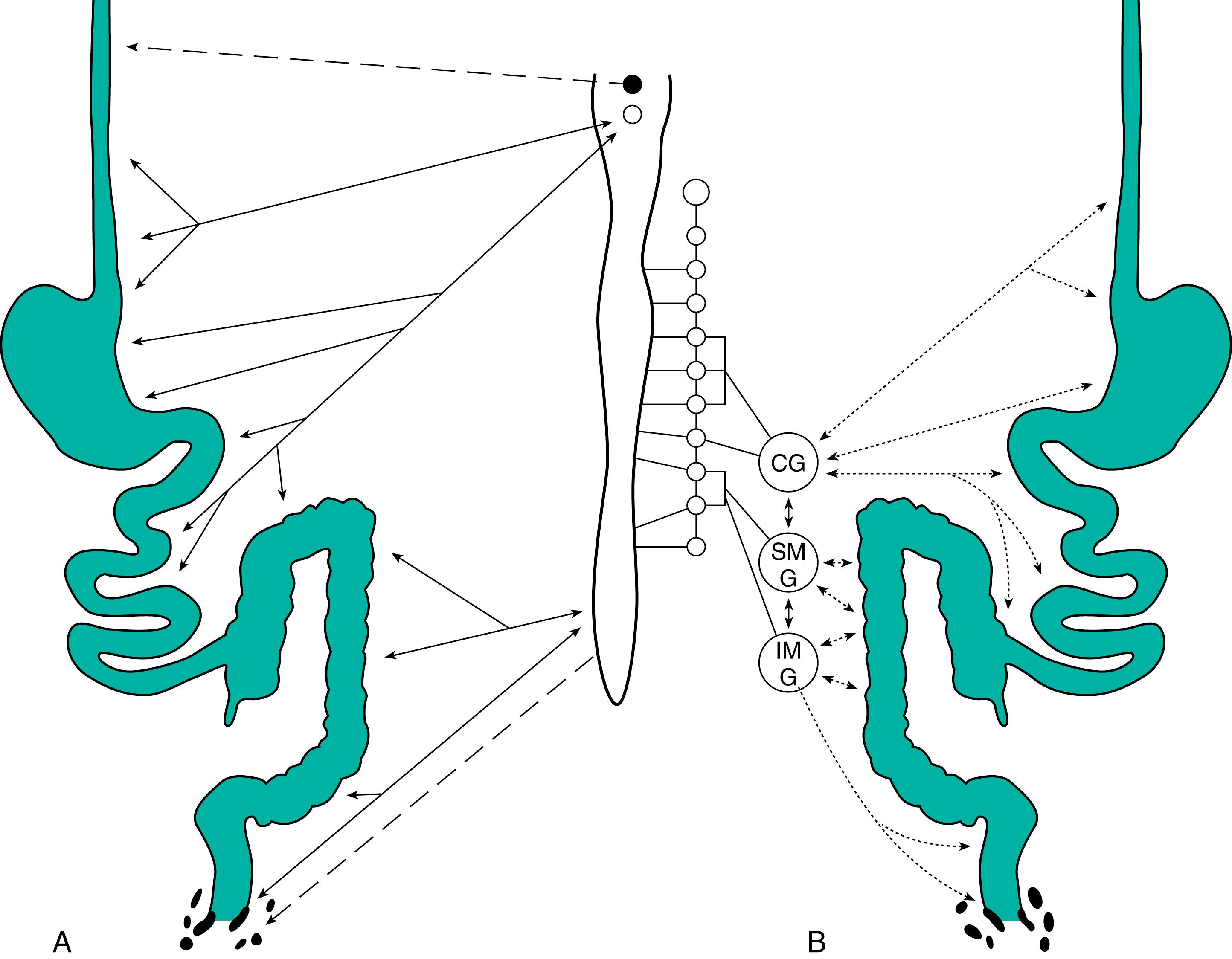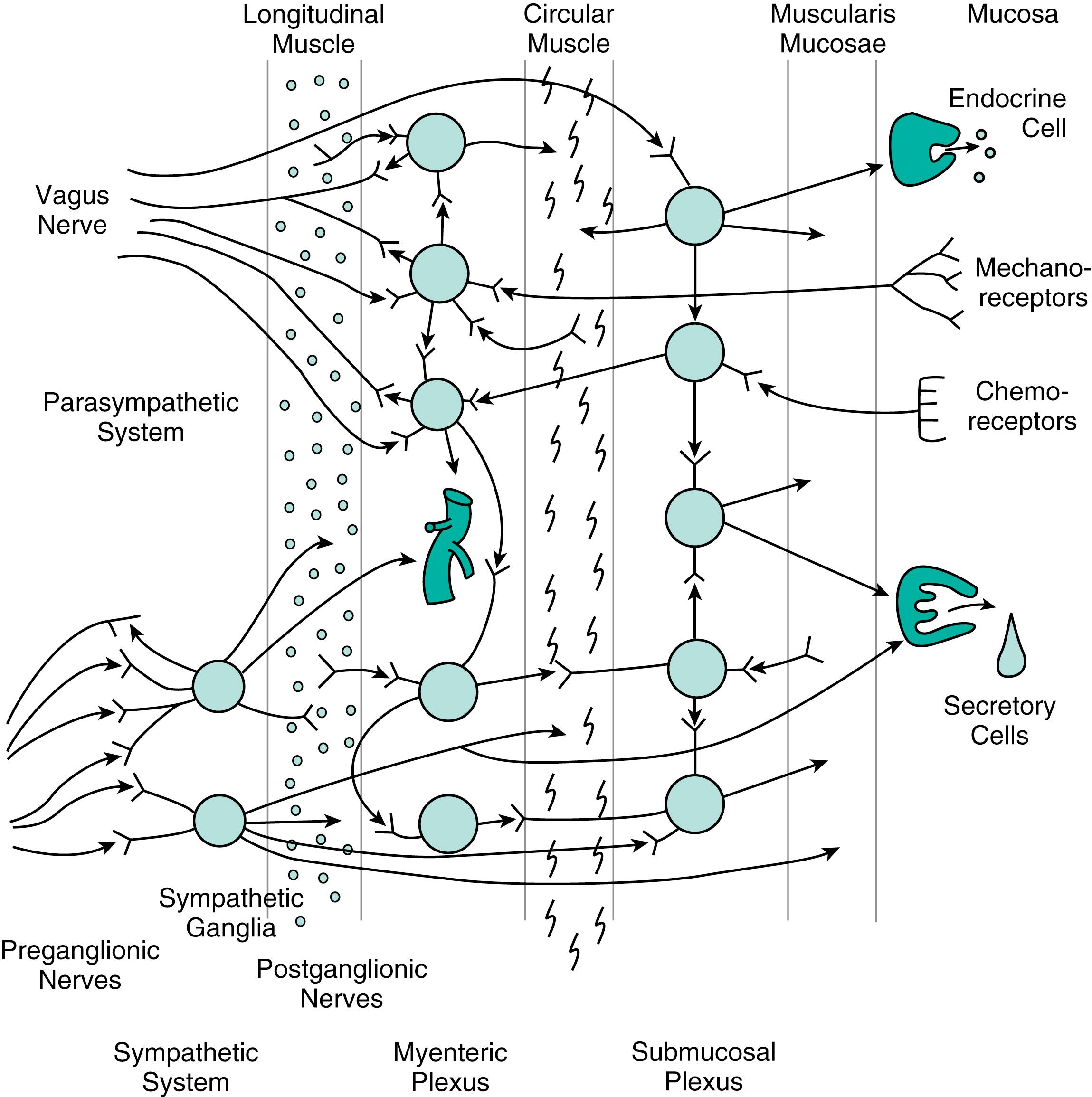Physical Address
304 North Cardinal St.
Dorchester Center, MA 02124
Understand the anatomy and functions of the enteric nervous system and its relationship with the parasympathetic and sympathetic systems.
Describe the anatomy and types of contractions of smooth muscle cells.
Explain the role of calcium ion in the contraction and relaxation of smooth muscle cells.
Understand the roles of the interstitial cells of Cajal and slow waves in the contraction of smooth muscle cells.
Secretory, motility, and absorptive functions of the gastrointestinal (GI) system are integrated to digest food and absorb nutrients and to maintain homeostasis between meals. This integration is mediated by regulatory systems that monitor events within the body (primarily the GI tract) and in the external environment. In Chapter 1 , the important mediators released from endocrine, paracrine, and neurocrine cells were discussed. In this chapter, the role of the nervous system is considered in more detail.
Although the regulatory systems act to integrate the activities of the GI system, most secretory, absorptive, and muscle cells possess intrinsic activities that give them a degree of autonomy. Thus function arises out of the interaction of regulatory systems and local intrinsic properties. The basic properties and intrinsic activities of each type of secretory and absorptive cell are discussed in separate chapters that deal with the secretion and absorption of specific chemicals. The basic properties and intrinsic activities of the smooth muscle cells are discussed in this chapter.
The GI tract is innervated by the autonomic nervous system (ANS). It is called the ANS because, under normal circumstances, people neither are conscious of its activities nor exert any willful control over them. The ANS can be divided into the extrinsic nervous system and the intrinsic, or enteric, nervous system.
The extrinsic nervous system is in turn divided into parasympathetic and sympathetic branches ( Fig. 2.1 ). Parasympathetic innervation is supplied primarily by the vagus and pelvic nerves. Long preganglionic axons arise from cell bodies within the medulla of the brain and the sacral region of the spinal cord. These preganglionic nerves enter the various organs of the GI tract, where they synapse mainly with cells of the enteric nervous system ( Fig. 2.2 ). In addition, these same nerve bundles contain many afferent nerves whose receptors lie within the various tissues of the gut. These nerves project to the brain and spinal cord to provide sensory input for integration. Approximately 75% of the fibers within the vagus nerve are afferent. Thus information can be relayed from the GI tract to the medulla and integrated, and a message can be sent back to the tract that may influence motility, secretion, or the release of a hormone. These long or vagovagal reflexes play important roles in regulating GI functions.


Sympathetic innervation is supplied by nerves that run between the spinal cord and the prevertebral ganglia and between these ganglia and the organs of the gut. Preganglionic efferent fibers arise within the spinal cord and end in the prevertebral ganglia. Postganglionic fibers from these ganglia then innervate primarily the elements of the enteric nervous system (see Fig. 2.1 ). Few fibers end directly on secretory, absorptive, or muscle cells. Afferent fibers also are present within the sympathetic division. These nerves project back to the prevertebral ganglia and/or the spinal cord. Thus an abundance of sensory information also is available via these nerves.
Elements of the intrinsic , or enteric , nervous system are grouped into several anatomically distinct networks, of which the myenteric and submucosal plexuses (see Fig. 2.2 ) are the most prominent. These plexuses consist of nerve cell bodies, axons, dendrites, and nerve endings. Processes from the neurons of the plexuses do not just innervate target cells such as smooth muscle, secretory cells, and absorptive cells. They also connect to sensory receptors and interdigitate with processes from other neurons located both inside and outside the plexus. Thus pathways within the enteric nervous system can be multisynaptic, and integration of activities can take place entirely within the enteric nervous system (see Fig. 2.2 ), as well as in the ganglia of the extrinsic nerves, the spinal cord, and the brainstem.
Many chemicals serve as neurocrines within the ANS. Several of these chemicals have been localized within specific pathways, and a few have defined physiologic roles. Most of the extrinsic, preganglionic, efferent fibers contain acetylcholine (ACh). This transmitter exerts its action on neurons contained within the prevertebral ganglia and enteric nervous system. Norepinephrine is found in many nerve endings of the postganglionic efferent nerves of the sympathetic nervous system. This transmitter also exerts its effects primarily on neurons of the enteric nervous system. Within the enteric nervous system, ACh, serotonin , vasoactive intestinal peptide (VIP), nitric oxide (NO), and somatostatin have been localized to interneurons. ACh and the tachykinins (TKs) (e.g., substance P ) have been localized to nerves that are excitatory to the muscle; VIP and NO have been localized to inhibitory nerves to the muscle. In many instances, more than one transmitter can be localized to the same nerve. The goals of mapping neural circuits within the extrinsic and enteric nervous system and elucidating their functions are far from complete.
Become a Clinical Tree membership for Full access and enjoy Unlimited articles
If you are a member. Log in here